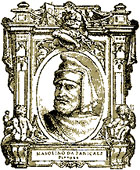|
MASOLINO DA PANICALE
Painter of Florence
(1383-1447)
 I FEEL sure that the satisfaction of those who approach the topmost degree in the profession to which they devote themselves must be very great, for, besides the pleasure which they have in producing good work, they enjoy some fruits of their labours, and no doubt live peacefully and happily. If it chance that one is overtaken by death as he is progressing towards perfection in any science or art, his memory will not be completely lost if he has really taken pains to aim at the true end of art. Therefore everyone ought to exert himself to the utmost to attain to perfection, because, even if he is interrupted in mid- career, he will obtain praise, if not for the works which he was unable to complete, at least for his good intentions and the careful study displayed in the little that remains. Masolino da Panicale of Valdelsa, who was a pupil of Lorenzodi Ghiberti, 1 and an excellent goldsmith in his youth, being the best finisher that Lorenzo had for his doors, was very dexterous and skilful in making the draperies of figures, and possessed a good style and intelligence in finishing. He used his chisel very skilfully in representing creases, both in human limbs and in draperies. At the age of nineteen he devoted himself to painting, and practised that art ever afterwards, learning colouring from Gherardo dello Starnina. He went to Rome to study, and while there did the hall of the old Orsinihouse on Monte Giordano. He subsequently returned to Florence because the air of Rome gave him headaches, and in the Carmine, next to the chapel of the Crucified; he did the St. Peter which may still be seen there. As this was praised by ‚artists, it led to the Brancacci Chapel in the same church being alloted to him. Here he did scenes from the life of St. Peter, a part of which he completed with great diligence, Comprising the four Evangelists on the vaulting, Christ calling Andrew and Peter from their nets, Peter weeping at the sin of his denial, and his preaching to convert the people. 2 Here also he painted the shipwreck of the Apostles, and St. Peter curing his daughter Petronilla. In the same scene he represented Peter and John going to the Temple and healing by a sign of the cross before the porch the poor cripple who asks an alms, and to whom they can give neither silver nor gold.
The figures in the whole of this work are made with remarkable grace, and there is a nobility in their bearing, beauty and harmony in the colouring, and power and relief in the design. The work was much admired for its novelty, it being in many respects wholly foreign to the manner of Giotto, but Masolino was over taken by death while it was still imperfect. He was a man of excellent intellect, his paintings display great harmony and facility, and he completed them with much diligence and devotion. This ardour for study and desire to take pains which always animated him exercised an injurious influence upon his health, and brought him to the grave before his time, removing him from the world too cruelly. Masolino died young at the age of thirty-seven, disappointing the expectations which were held of him. His paintings were made about 1440. Paolo Schiavo took great pains to imitate his style, and made a Madonna at the comer of the Gori in Florence, with figures whose feet are fore- shortened. I have frequently examined Masolino's works, and have found his style very different from that of his predecessors, for he endowed his figures with majesty, and made the draperies soft, falling in elegant folds. The heads of his figures, too, are much superior to those of his predecessors, for he discovered a better method of treating the eyes, and many other parts of the body. He also began to understand the art of light and shade, for he worked in relief, and achieved many difficult foreshortenings admirably, such, for instance, as the poor man who is asking alms of St. Peter, his leg thrust out behind him, so that by means of the shadows on the colouring and the outline of the design he actually appears to be kicking the wall. Masolino further introduced a softer air into the faces of his women, and gave brighter clothes to his youths than the old artists had done, and he was fairly skillful in perspective. But the matter in which he chiefly excelled was colouring in fresco, his paintings being coloured and shaded with such grace that the flesh-tints possess an indescribable beauty. If he had been a perfect designer, as he might have been had he lived longer, he would have been numbered among the greatest, for his works are executed with grace, in a noble style, with beautiful and harmonious colouring and considerable power and relief in design, though this is not absolutely perfect. 1 Tommaso di Cristoforo Fini.2 Begun 1422. Some critics deny that he did any work in this chapel.
Index of Artists
|
| Alberti, Leon Battista
Angelico, Fra Giovanni
Bartolommeo, Fra
Bartolommeo, Don
Bellini, Jacopo, Giovanni, and Gentile
Botticelli, Sandro
Brunelleschi, Filippo
Buonaroti, Michelangelo
da Correggio, Antonio
da Fontormo, Jacopo
da Panicale, Masolino
da Settingnano, Desiderio
da Urbino, Bramante
da Vinci, Leonardo
del Sarto, Andrea
di Cosimo, Piero
Donatello,
Francesca, Piero Della
Gallo, Guillano and Antonio
Ghiberti, Lorenzo
| Ghirlandajo, Domenico
Giovanni, Masaccio
Lippi, Fra Filippo
Lippi, Filippo
Mantegna, Andrea
Michelozzi, Michelozzo
Perugino, Pietro
Pinturicchio, Bernardino
Pollajuolo, Antonio and Piero
Quercia, Jacopo Dalla
Raphael,
Robbia, Luca Della
Romano, Giulio
Rosselino, Antonio
Rosselli, Cosimo
Rossi, Rosso
Signorelli, Luca
Veneziano, Sebastiano
Verrocchio, Andrea
|
|